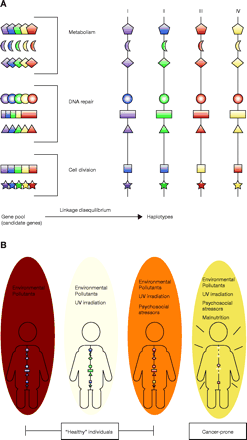
- Institution: Stanford Univ Med Ctr Lane Med Lib/Periodical Dept/Rm L109
- Sign In as Member / Individual
The Environmental Genome Project

Human health as a function of the interrelationship between the genome and the environment. A. Eight hypothetical genes, involved in toxicant metabolism, DNA repair, or cell division, are represented as distinct geometries. Each of the eight genes can be found, in a given population, in five allelic variations (represented by five variations of color in the schematic). Due to linkage disequilibrium, however, the combinatorial variation of the eight genes in terms of alleles is limited; the combination of alleles that typifies an individual is referred to as a haplotype. In the schematized example, four haplotypes are seen to result in consideration of the eight genes selected for analysis (i.e., the eight candidate genes); for heuristic purposes, haplotype IV will be defined as a rare haplotype. B. A variety of environmental stressors can affect diseases, but the roles of individual candidate genes in these diseases may be difficult to assess. In the three environments indicated on the left, any of the four haplotypes may adequately respond to stress (although only one haplotype, selected at random, is shown in each environment), so that no disease phenotype is apparent; in this case, the term “wild-type” allele is purely arbitrary. In a fourth environment (yellow), a particular haplotype (here, the rare haplotype IV) may not be adequately robust (here, the yellow alleles are no longer visible) in the face of given stressors, in which case an association between “susceptible” alleles and disease may be made. The establishment of such associations is the ultimate goal of the Environmental Genome Project.


